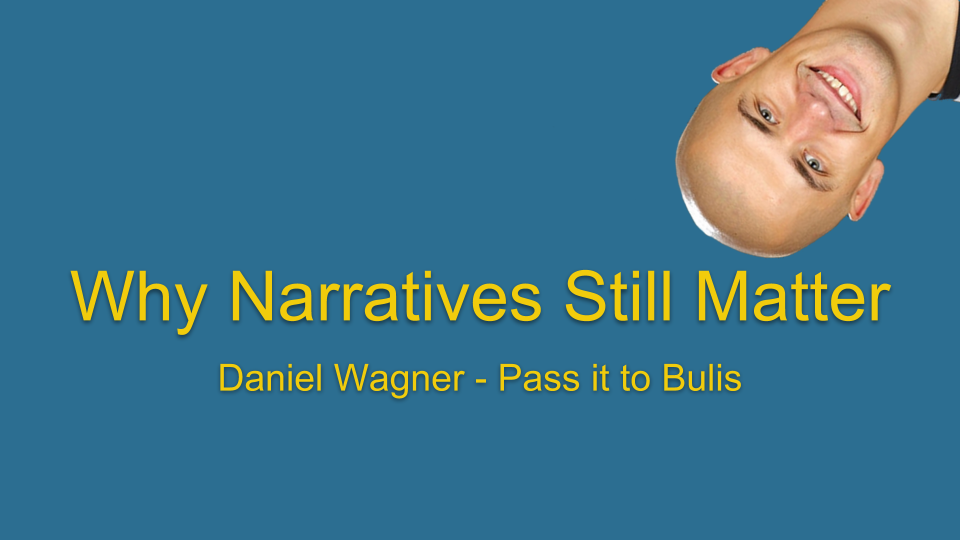I had the honour of presenting a talk at the 2018 Vancouver Hockey Analytics Conference on Saturday. I shared my perspective on narratives, which are often seen as being in opposition to more data-driven approaches to hockey.
You can watch a replay of my talk on the Periscope stream embedded below — click the link in the embedded tweet to view a wider angle — but I’ve also reproduced the talk in article form along with the slides, so you can read it if you would prefer.
VANHAC 2018 Afternoon https://t.co/oFyd63R2JB
— Emily Jo Michele (@emilyjomichele) March 3, 2018
My name is Daniel Wagner from the Canucks blog Pass it to Bulis at the Vancouver Courier. When I introduce myself as the guy from Pass it to Bulis, the most common response I used to get was, “I thought you were black.” That was the other guy.
I’ve been writing about hockey for about eight years. The last time I wrote any code apart from HTML was high school (those Java classes have been super useful) and I have no idea how to scrape my own data, so the annual Closing of the Hockey Stats Websites is a very stressful time for me.
I’m going to be talking about “Narratives,” which is a fun thing to discuss at an analytics conference. I am here to tell you that the thing I'm good at — writing stories — still matters, which is awfully convenient for me.
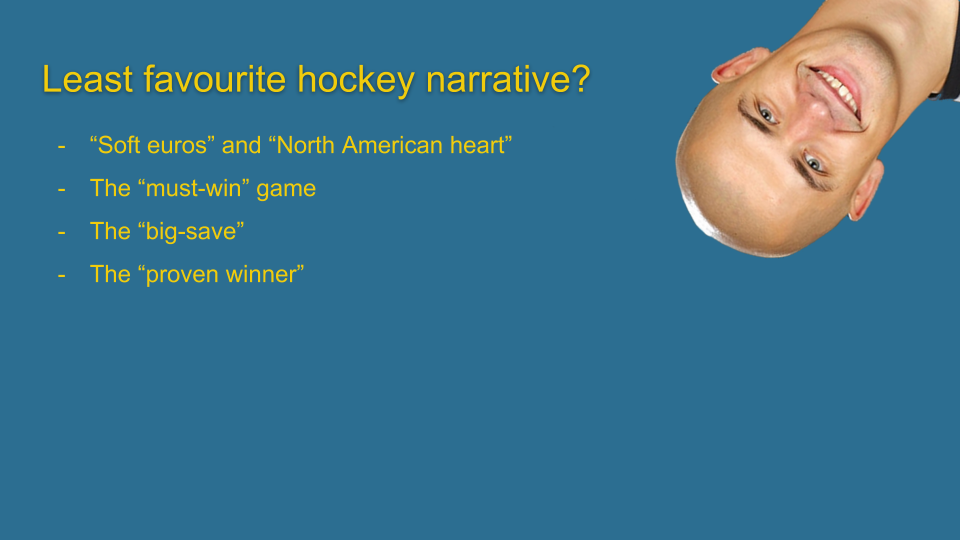
What is your least favourite hockey narrative? I have a few that get on my nerves: The xenophobic narratives of “soft euros” and “North American heart.” The “must-win game” is a clunker, particularly when it’s used early in a season. The goaltender who makes the “big save” when he needs to. Please just make all the saves. “He’s a proven winner. That guy just wins.” And its opposite: “He just can’t win the big game. He never comes through when it matters.”

That’s me. I’m probably five or six years old in that picture. I share this picture not just because I used to be really cute and it might disarm you, but also because it’s not long before I first began writing about sports.
When I was a kid, I used to stage elaborate sports games with my stuffed animals. I would split them up into teams and I would act out a hockey game or soccer game, even football, basketball, and volleyball. I have some memories of doing this, but I also have some direct textual evidence. I wrote about it in a notebook: little game stories in big awkward letters, my earliest sportswriting, all about a stuffed kangaroo scoring the game-winning goal off a great pass from a tie-dye patterned triceratops.
And with those game recaps, I included a rudimentary boxscore, like I saw in the sports section of the newspaper. A record of how many goals were scored by each stuffed animal, along with a final score.
Narrative and numbers, side-by-side, like dogs and cats living together, mass hysteria.
The numbers of hockey always mattered a lot to me, likely because I spent more time staring at the back of my hockey cards than actually watching games. With no cable, the NHL was only on TV on Saturdays, though I did go to Chilliwack Chiefs games regularly with my grandpa. But the numbers on the backs of the hockey cards fascinated me. I would compare them to each other endlessly, trying to decide who was the best player on each team, and whether goals were more important than assists, and what the heck did “PIM” mean?
When I started Pass it to Bulis, it was just a few years into the Behind the Net era and I was as confused by the names and abbreviations of statistics as I was by “PIM” as a kid. But I read and learned a ton and, gradually, I began moving from purely qualitative writing to a more quantitative approach and began making my own meagre contributions to the fancy stats conversation. It started with these two Canucks: Kyle Wellwood and Manny Malhotra.

These two players represent my earliest forays into analytics. The articles that I wrote about them have some pretty significant flaws, so please be kind if you happen to hunt them down after this talk, but they illustrate a couple key things.
Kyle Wellwood: Defensive Superstar?
The narrative around Wellwood was defined by a single picture, which I’m going to be kind enough to not include on a slide. A picture of him sitting by a pool, looking soft and weak.
I had a soft spot for Wellwood because I found him very relatable. My defining memory of Wellwood as a Canuck was at Superskills one year. During a break, all of his teammates were gathered along the boards talking and laughing, but Wellwood spend the break by himself in a faceoff circle, lying down on the ice, lounging. He was propped up on one elbow, but was still making a puck dance with his stickhandling. If anyone could combine lounging with stickhandling, it was Wellwood.
It was a statistic, however, that changed the way I viewed him. We’d now call it goals against per 60 minutes: in the 2009-10 season, among skaters who played at least 500 minutes, Wellwood had the lowest goals against per 60 in the entire NHL.
That changed the way I watched Wellwood on the ice, as I started to notice how he always seemed to be in the right spot in the defensive zone to get the puck and how he seemingly never failed to get the puck out of the zone once he had it.
That statistic changed the narrative for me: a small, soft, skilled centre could be an effective defensive player.
Memories of Kyle Wellwood's defensive prowess with the Canucks while @passittobulis talks: #vanhac pic.twitter.com/0TeAicuxHy
— Micah Blake McCurdy (@IneffectiveMath) March 3, 2018
Manny Malhotra is an Enabler
This article came during the 2010-11 season when Ryan Kesler won the Selke. During the season, it appeared to me that Kesler was having to carry a lot less of defensive burden with the addition of Malhotra to the lineup. He was the one taking most of the defensive zone faceoffs and taking on the toughest competition. Meanwhile the Sedins always seemed to be taking faceoffs in the offensive zone.
Thanks to Behind the Net, I was able to see if there were numbers to back up my eye test. There were.
So I shared the narrative that Malhotra enabled offensive production from the Sedins and Kesler by taking on a higher Quality of Competition and percentage of defensive zone starts. Those statistics informed my narrative.
I wouldn’t write those two articles the same way now, as my understanding of analytics has changed, but my point is that the numbers didn’t replace the narrative; they informed it.
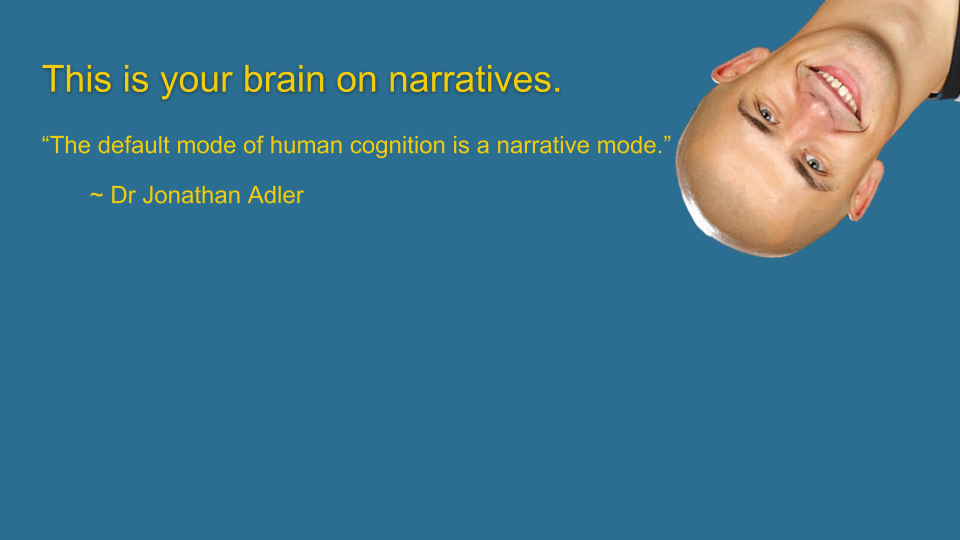
In general, narrative is how humans process the world. Humans don’t just search for a narrative; they actively create one. It’s part of making sense of the world, finding meaning, and defining who you are as a person.
You have a life story, some way of explaining how you got from who you were to who you are. The most disorienting moments in our lives usually come when that life story, that narrative, is threatened or falls apart.
The problem, of course, is that the narrative doesn’t always accurately reflect reality. This is clearly true when it comes to sports. The narratives that sports fans have constructed to explain what happens on the ice, the court, or the field may bear only a passing resemblance to what has actually occurred.
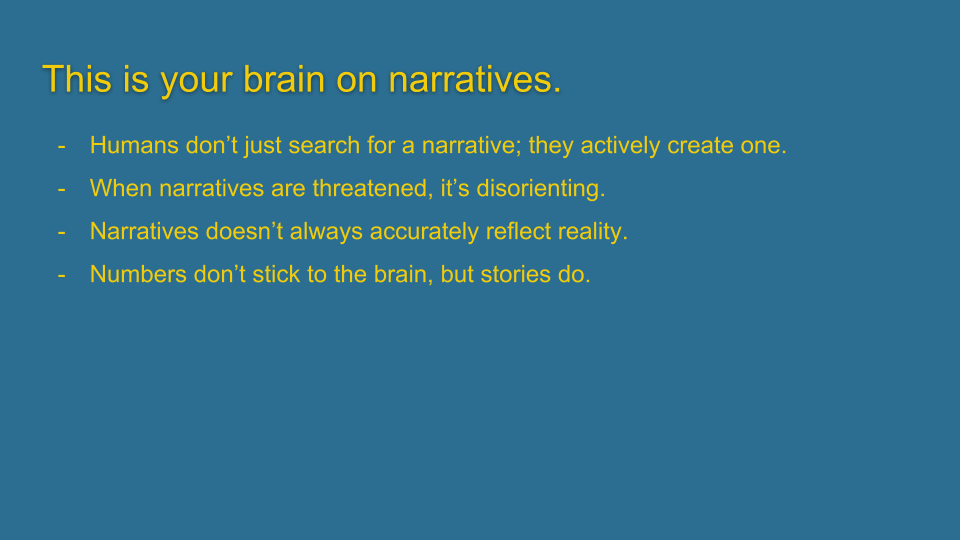
The human brain is incredible, but it has its flaws. For one, it’s not good at holding a lot of numbers or independently assessing thousands of individual events. It’s one of the reasons why analytics are so important — they can capture what the eyes miss and the brain can’t collate — but it’s also one of the reasons why analytics are such a hard sell to a lot of fans, players, coaches, and management.
Numbers don’t stick to the brain, but stories do.
A series of bullet points or a row of numbers engages a limited section of the brain, essentially just the part that processes language. You’re processing these bullet points right now: you can read them, understand them. But they’re not engaging your brain any more than that. You’ll probably forget them an hour from now, if not by the time I switch to the next slide.
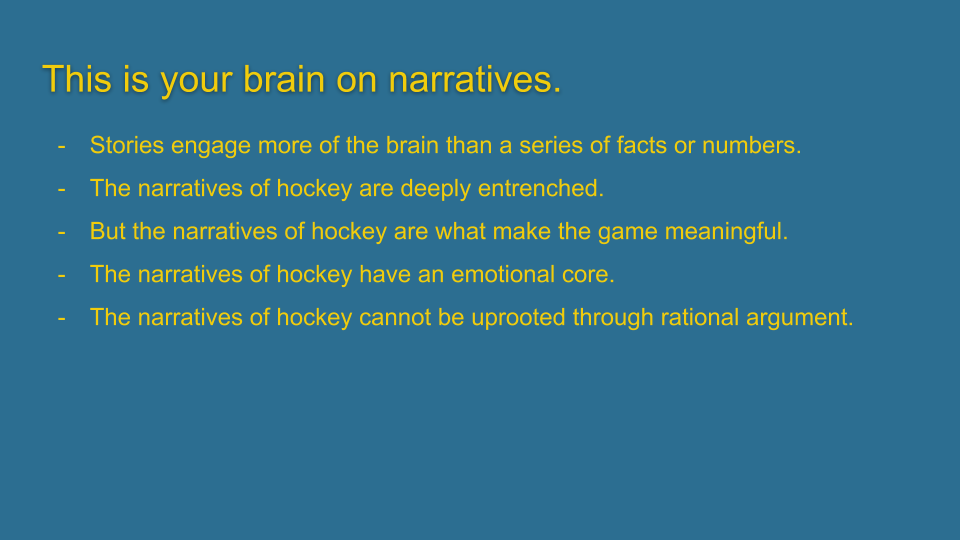
Studies show that stories light up larger areas of the brain. Reading or hearing about a certain smell, taste, or sound, engages the portions of the brain that processes those senses, as if your brain was actually experiencing them.
Why does this matter for analytics? The issue is the narratives of hockey are deeply entrenched. They’re not just something that a fan, player, or journalist believes, but something they’ve experienced. The narrative gets constantly reinforced as the stories are retold, lighting up the brain. Those narratives are how fans (or players, coaches, managers, etc.) make sense of the game and when those narratives are threatened, it’s disorienting and they resist.
There’s another issue: the narratives of hockey are what make the game meaningful.
Hockey has no inherent meaning; it’s just a game, except for the stories that surround it. Without the narratives, there is no hockey as we know it. It becomes meaningless. You don’t want to do away with narratives entirely, because there would be nothing left.
The issue is when narratives don’t reflect reality. Let’s say you don’t believe in the narrative that an enforcer protects his teammates. Perhaps you have data that shows that fighting does not lead to winning, nor does it prevent injuries.
That data will connect with a small portion of a person’s brain, but the enforcer narrative lights up the same part of the brain that initially lit up when that person was watching Gino Odjick take on all comers while skating on a line with Pavel Bure or Dave Semenko riding shotgun with Wayne Gretzky. Or for someone who played, it consciously or subconsciously brings to mind the emotion or feeling of safety when playing alongside one of those enforcers. That narrative isn’t a rational argument; it has an emotional core. You can’t defeat that narrative with numbers.
The numbers help, of course, particularly to a knowledgeable writer. I firmly believe it is the responsibility of hockey writers, analysts, radio hosts, and TV personalities to be as familiar as possible with both the basics of hockey analytics and the latest developments in analytics in the public sphere. They’re doing their audience a disservice, but also themselves a disservice. Analytics provides opportunities to tell new and different stories, which should always be the aim of a storyteller.
Storytelling matters, because the lousy narratives of hockey cannot be uprooted through rational argument.
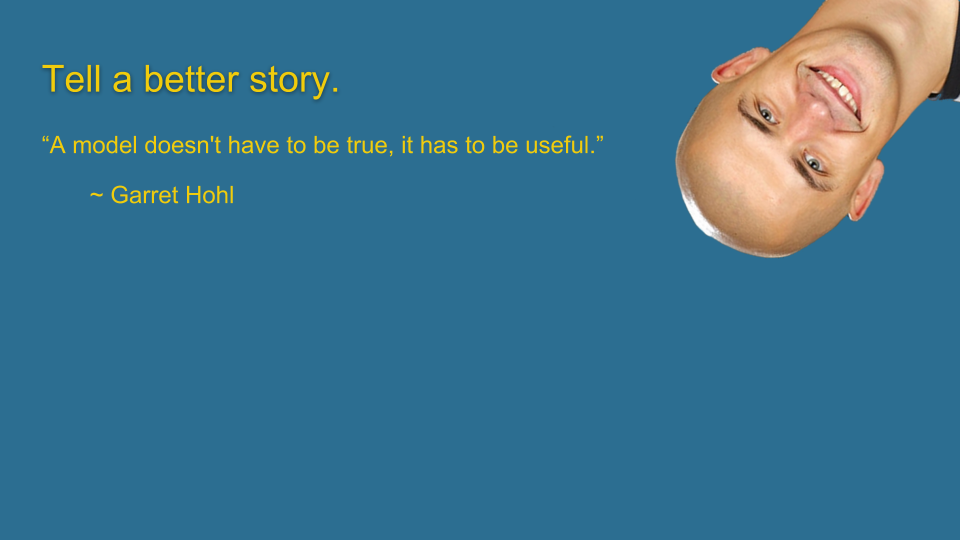
This quote from Garret is paraphrasing another quote we saw from our keynote speaker. It strikes me that it rings true for stories as well. Statistical models are imperfect representations of real-world events. They’re not “true,” but if the model is useful, it’s worthwhile. A narrative is also an imperfect representation of real-world events, but it too can be useful.
What would you say has done more to advance the cause of analytics in sports in popular culture than anything else?
Moneyball. Yes, I’m going to be the guy who talks about Moneyball at a sports analytics conference, because I am a dreadful cliche.
What is Moneyball about? On the one hand it’s about using statistical analysis to take advantage of market inefficiencies. But no one is going to make that movie and, if they do, it’s not going to star Brad Pitt.
Moneyball is a story. It’s a narrative. It’s the tale of Billy Beane and how he managed the 2002 Oakland Athletics to the playoffs, despite their salary constraints, and turned the baseball world upside-down. It’s an underdog story that captures the imagination, gets as many segments of your brain firing as possible, then grabs your imagination and your brain and forces them to pay attention to statistics.
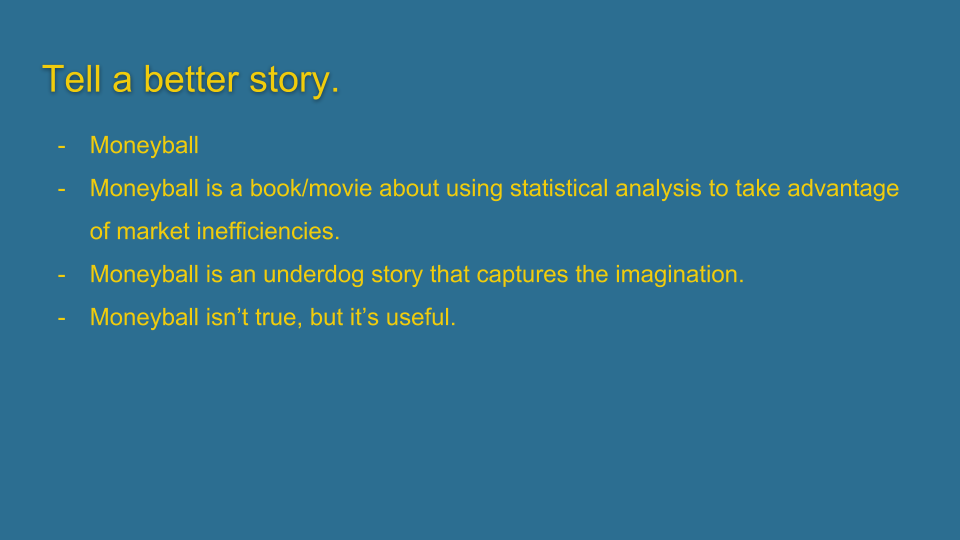
Is Moneyball 100% true? No. It glosses over a lot of elements other than analytics that made the A’s successful, particularly their pitching. It hypes up players that had a limited impact to the A’s success because they fit the theme of the book. But Moneyball is useful, introducing a different way to look at baseball into the popular culture.
There are other books, websites, articles that are more “true” than Moneyball, but lack the well-told narrative with compelling characters like Beane, catcher-turned-first-baseman Scott Hatteberg, and submarine pitcher Chad Bradford.
Would these ideas disseminate without the narrative? To a certain extent, of course. But they wouldn’t have anywhere near the reach and impact on a larger audience.
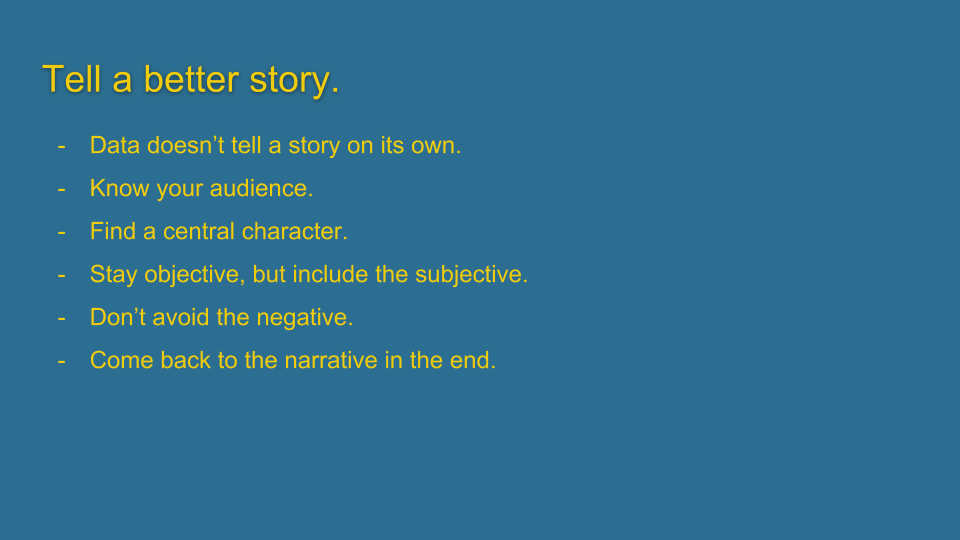
Data doesn’t tell a story on its own.
You need to tell the story. This is applicable whether you want to have an impact on the larger hockey world or if you just want to change one person’s mind. If you want to change the lousy narratives in hockey, you need more than good data and analysis; you need a better narrative.
So how do you tell a better story? That’s a topic all on its own, but here is a quick overview that might help.
First, know your audience. It’s entirely possible that all you want to do is preach to the choir. If your audience is those with an in-depth understanding of statistics, feel free to go with less narrative and more numbers, though a story-based hook is still a good idea. If it’s a lay audience with less familiarity with statistics, lean on your narrative. When you define your data, provide a metaphor or an example. Give them a reason to get engaged with your analysis.
Find a central character, a player or team that provides a good illustration for your data.
Stay objective, but include the subjective. Is there a hook that can get people interested in your central character? Moneyball focused on the pitcher with the submarine delivery so low that his knuckles scraped the ground. That’s a detail that lights up the part of the brain dealing with touch. Also, there’s the story of the catcher who converted to first base and how important that new contract was to him and his family. That emotional connection lights up parts of the brain that deal with social interaction and empathy.
These details help you remember why these people are important: pitchers that get outs are more important than looking good on the mound and getting on-base is more important than fielding. Those subjective details help people remember the analytical lesson you’re trying to impart.
What subjective details can add colour to your narrative to engage more of your audience’s brain? What does this player or team do well that can be seen or understood subjectively, but also shows up in your data or model?
Don’t avoid the negative. This is where narrative can be your best friend. If you have an outlier that doesn’t fit your data or model, often it doesn’t really matter from a statistical perspective, but those with a bone to pick may jump on those outliers as if they disprove everything else. If you have a narrative at the ready for those players or teams that don’t fit, you can explain it. Maybe in the telling of that story, you’ll end up discovering something interesting about that player or team that better informs your next statistical model.
Lastly, come back to the narrative in the end. Whatever way you are presenting your analysis — a blog post, conference, meeting — you can set the stage with a story, then present your analysis, but don’t neglect the narrative at the end. Coming back to your story will provide a more complete package that sticks with your audience.
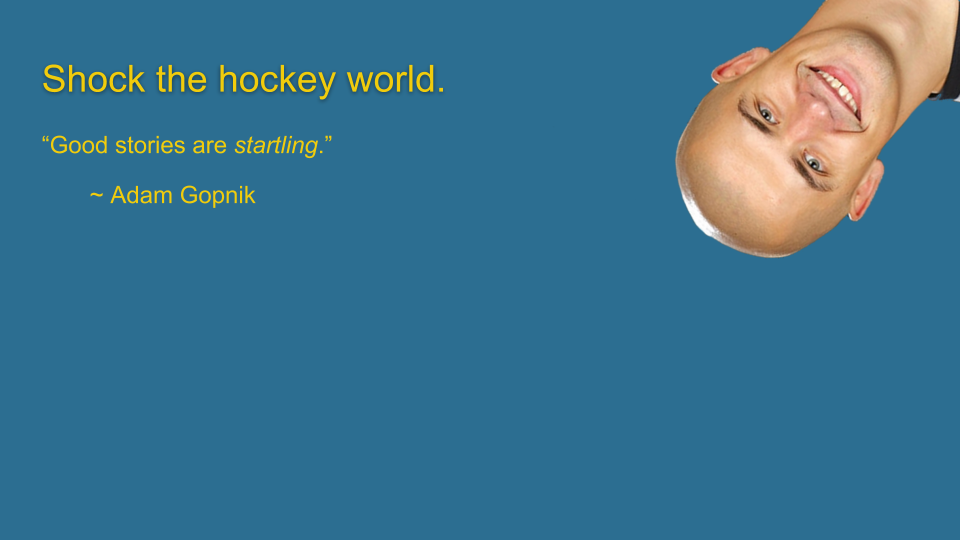
To finish off, here’s the rah-rah, cheerleading component of my talk.
The problem isn’t narrative itself; the problem is bad narratives.
So, I’m tasking you with taking those bad narratives apart. Undo those narratives. Find the data that disrupts those narratives and tell a better story with that data. Bad narratives can be toppled by better ones.
Tell a startling story that surprises people and it will stick with them.
Figure out why the soft kangaroo stuffy outscores the grittier, tougher tie-dyed triceratops.
Upset people. Startle them. Buck tradition. Go out there and shock the hockey world.
